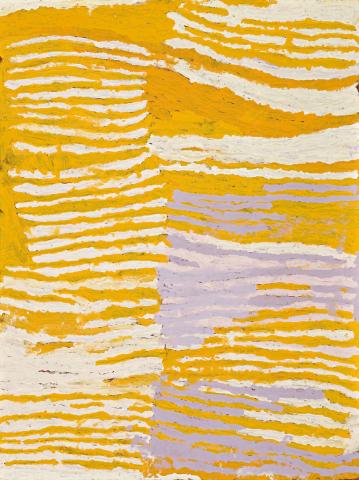LUPULNGA, 2007
Makinti Napanangka
synthetic polymer paint on linen
121.5 x 91.0 cm
inscribed verso: artist's name, size, Papunya Tula Artists cat. MN0711141
Papunya Tula Artists, Alice Springs
The Collection of William and Lucy Mora, Melbourne
This painting is accompanied by a certificate of authenticity from Papunya Tula Artists, Alice Springs, which reads: 'This painting depicts designs associated with the site of Lupulnga, a rockhole situated south of the Kintore community. The Peewee (small bird) is associated with this site, as well as the Kungka Kutjarra or Two Travelling Women Dreaming. During ancestral times a group of women visited this site, holdings ceremonies associated with the area before continuing their travels north to Kaakuratintja (Lake MacDonald) and later to the Kintore area. The lines in the painting represent spun hair-string which is used in the making of nyimparra (hair belts) which are worn by both men and women during ceremonies.'
Makinti began painting in 1995, when she participated in the Kintore/ Haasts Bluff collaborative canvas project, 'Minyma Tjukurrpa'. The interest in Pintupi women's art arose in the mid-1990s, quite late in the history of the contemporary Aboriginal art movement. It was in 1996 that Makinti Napanangka, along with her cousin and painting companion, Tatali Nangala, began painting for Papunya Tula Artists. Born around 1930 in the Lake MacDonald region of Central Australia, she moved to Haasts Bluff with her husband, where she lived until Papunya was established in 1960.
Makinti Napanangka's paintings often consist of interwoven, lightly coloured lines, which represent the hairstring skirts of the 'Kungka Kutjarra' or Two Women, who feature prominently in Pintupi ancestral stories. Depicted in this painting, these hairstring skirts (Nyimparra) are worn by Pintupi women in their ceremonies when they reaffirm these mythological stories through dance and song.
